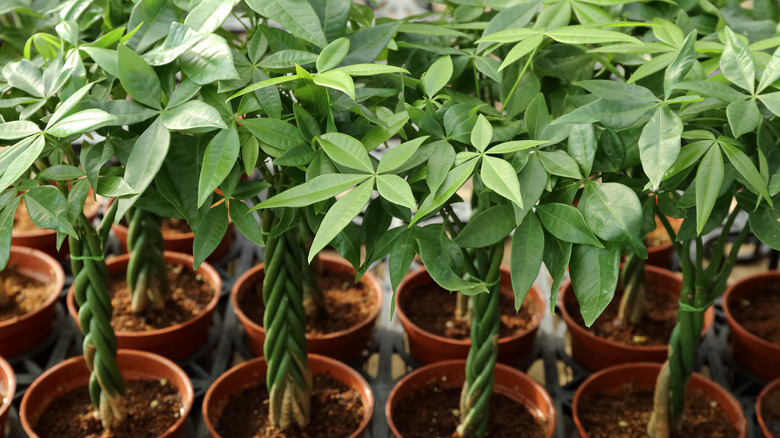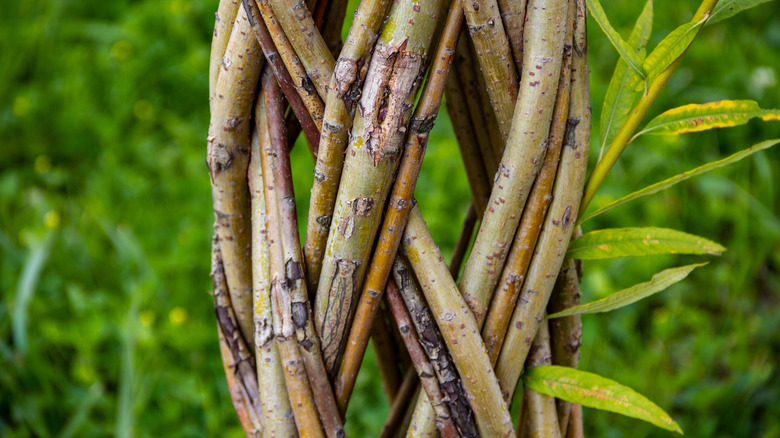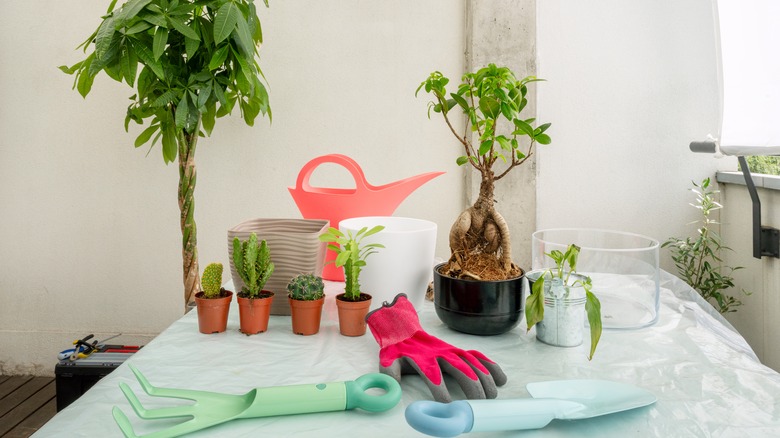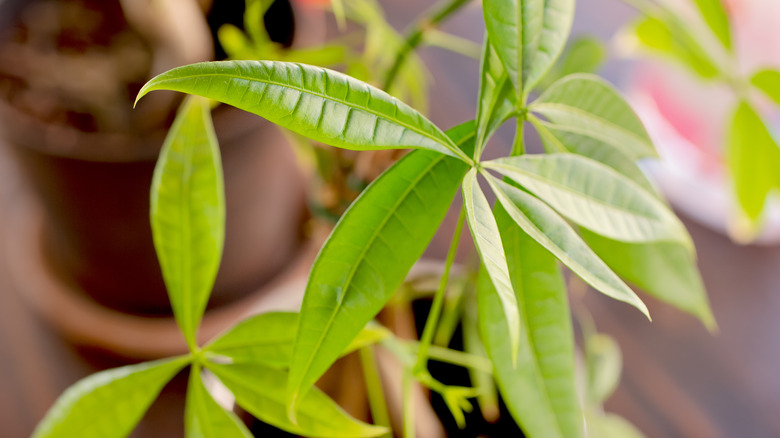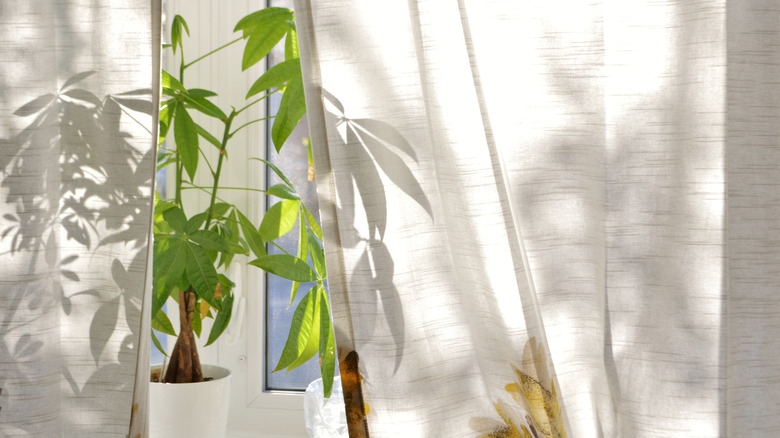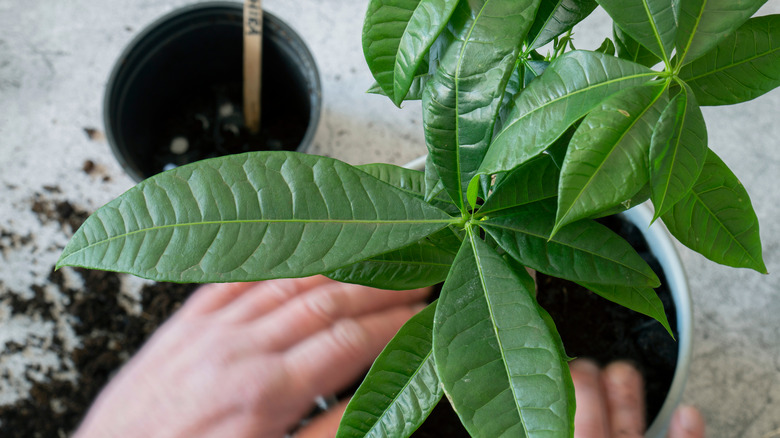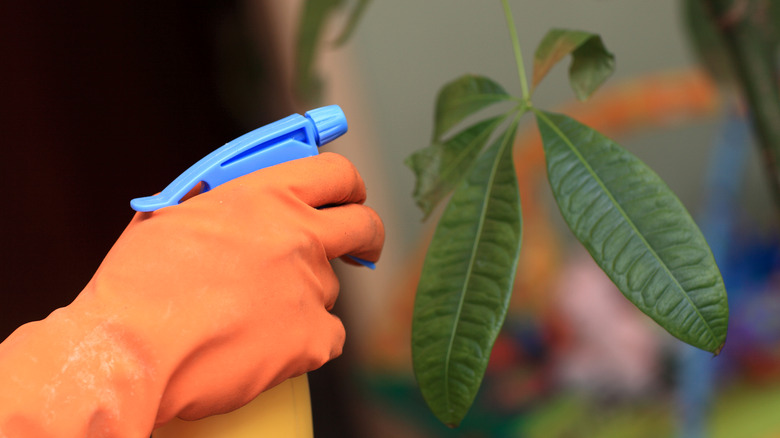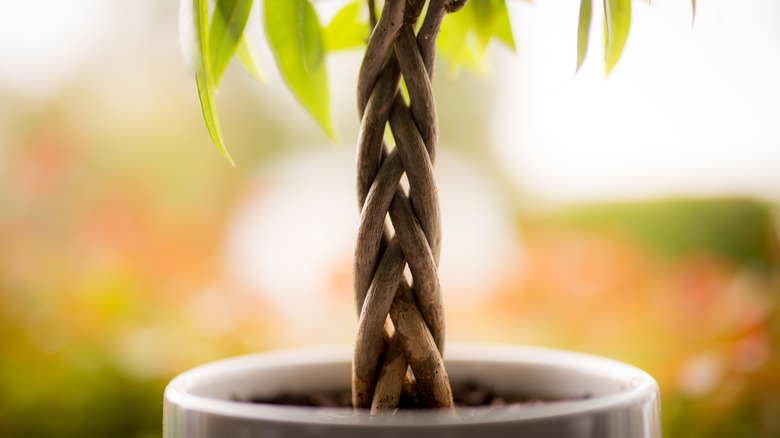How To Grow And Care For A Money Tree
Pachira aquatica, also known as money trees, or Guiana chestnuts, are tropical wetland trees originally from South and Central America where they grow in swamps, according to The Spruce. These trees have been used as houseplants since the 1980s, beginning in Taiwan. Over time, their popularity has spread across the globe. Today, you can find them in banks and other financial offices as well as in many homes. They are regarded as lucky, bringing their owners wealth and good fortune.
The money tree features long, thin, and waxy green leaves at the top of several skinny trucks. These trunks are normally braided while the tree is young. As the money tree grows, the braid continues to support the tall tree with a leafy head. Typically, these trees do not grow taller than eight feet tall when kept indoors. However, those grown outdoors can grow up to a whopping height of 60 feet. Growing a money tree indoors is relatively easy, given you allow it proper lighting and water. Luckily, overwatering a money tree is hard to do. If your plants tend to die from too much love, this houseplant is a good match for you.
How to use a money tree in the garden
You won't see money trees grown outdoors often, especially if you don't live in USDA zones 10 through 12, as reported by Gardening Channel, you won't be able to keep them alive. In the U.S., the very southern parts of Texas, California, and Florida are within these zones, as well as the entire state of Hawaii. Money trees prefer high humidity, heat, plenty of indirect sunlight, and almost no wind when residing outdoors.
When choosing a spot for your money tree outside, make sure that it is planted in a space where it will have some shade and some sunlight. If you are keeping it in a pot, try placing it on your porch, where your home will block the sun, suggested Garden Tabs. Planting your tree into the ground will allow it to grow much larger over time. Unless you plan to eventually have a large tree in your garden, you are best off leaving it in a pot where you can monitor its growth.
How to care for a money tree
Money trees are not the easiest houseplant to care for. If you are a beginner gardener, this may be a difficult plant to care for indoors. Money trees demand quite a bit of tedious care, but they are tolerant of neglect, as per Houseplant Help. When you first grow or buy your money tree choose a spot for it where it will receive plenty of indirect sunlight. Plan to keep your tree there for as long as possible. Money trees do not enjoy being moved around frequently. If you do end up moving your money tree, you will notice some leaves drop as it adjusts, said Gardening Know How.
These trees need quite a bit of water, but luckily you won't need to water yours every day. Regularly check how moist their soil is. When the top half of the tree's soil is dry, water it deeply until excess water appears in its saucer beneath the pot. Be sure to pour out extra water from the saucer after watering to prevent the money tree from standing in water. This can lead to root rot which will kill the plant. According to HGTV, you can use an all-purpose fertilizer to feed your money tree during its growing season in the spring and summer. There is no need to feed it in the winter. Diluting your fertilizer halfway with water will have the best results on your tree.
How to grow a money tree
Buying a pre-grown money tree is certainly the easiest way to incorporate one in your home. Yet, if you like the process of starting a tree from a seed, we can help you with that too.
To grow a money tree, you don't need to bury a bag of money. Luckily, planting a money tree is much cheaper. Money tree seeds look like small nuts, explained Sunday Gardener. If you find a seed that is damaged, discard it. Use a pot that is 6 to 8 inches in diameter with a draining hole. The soil you use should be nutrient-rich and well-draining. Even better soil for money trees is peat-moss based and includes gravel or sand for better draining. Thoroughly water your soil before planting your seeds. On the seeds, you'll notice a white "eye," be sure this is facing out toward the edge of the pot. Push each seed ¼ of an inch into the soil and cover if needed.
Propagating a money tree from cuttings is easier if you have access to an actively growing tree. Do this in the summer or spring for best results. According to The Spruce, you should begin by removing a couple of 4- to 6-inch stems. They should have a few leaves at the top. Place your cuttings in some water and wait a few weeks for them to start growing roots. Once properly developed, transplant your cuttings into soil.
Is a money tree toxic?
Money trees are non-toxic to cats, dogs, and horses, indicated the ASPCA. Though you definitely shouldn't be feeding it to your pets. Inside the money tree's leaves are irritating saponins. Ingesting them could lead to mild cases of vomiting, loose stool, and even diarrhea. If your pets are prone to eating your houseplants, consider placing your money tree on a high shelf or in a room where they can't get to it.
Sodalite Minds suggested keeping a close eye on your money tree to make sure your pet has not eaten any of its leaves. When you notice leaves chewed and left on the ground, call your nearest veterinary hospital to learn what to do next. Since money trees normally have mild effects on pets, even when ingested, your dog or cat will likely only have an upset stomach. The vet may advise you to encourage your animal to drink plenty of water to flush the toxins out of its body.
How to repot a money tree
The repotting of your money tree should take place every two years. However, if your money tree appears happy and has reached its growing height, you can simply refresh the top layer of soil instead of repotting the entire plant Some reasons you may need to repot your tree earlier include pest infestations, root rot, or if it's become root-bound, said The Healthy Houseplant. For your money tree, the transplanting process can be stressful. They prefer staying in their pots for as long as possible. Only repotting your tree when necessary will help you avoid transplant shock..
To repot your money tree, start by choosing a new pot that is only slightly larger. Too big of a pot or too small of a pot will hurt your tree. Then, use a clean peat mixture for soil, as explained by Gardening Know How. To get your tree out of its pot, hold the plant at its base and flip the pot over. If it doesn't slide out, do not pull on it. Instead, you should run a flat tool along where the soil meets the pot to loosen it. Once it comes out, gently untangle the roots and shake out the old soil before placing it in its new pot with soil. When you are finished, you can thoroughly water your money tree. Be sure to watch for any signs of illness, poor drainage, and shock in the following weeks.
Money trees' common pests and diseases
When you keep a money tree as a houseplant indoors, it's unlikely that you'll have to deal with pests. Most of the problems you'll encounter will have to do with watering, sunlight, and humidity. If you water your tree too often or expose it to too much sunlight, its leaves will begin showing brown spots, or it could develop root rot. You can correct this by watering your money tree to the correct specifications and shielding it from the hot midday sun. In some cases, you will need to repot the tree to cut away brown mushy roots indicative of root rot.
Some pests your tree may face include spider mites, scales, aphids, and mealybugs, explained Gardening Channel. In fact, many of your household plants can be tormented by these insects. Spider mites, aphids, and mealybugs can all be dislodged by spraying water mixed with soap onto all parts of your tree. Scales are most often found on the trunks of money trees. You can choose to pick them off one by one or coat the trunks in oil to kill them.
How to braid a money tree
Lots of people are drawn to money trees for their beautifully braided trunks. If you didn't grow yours from a seed or propagate it, your money tree probably came pre-braided from a nursery. When this is the case, make sure that you continue to braid yours as it grows so it looks uniform. The money tree will likely grow side shoots. You will want to trim these as you notice them.
Money trees that are propagated or grown from seeds will need to be braided once their trunks are longer than 14 inches. This process is not at all like braiding hair. You may only need to braid three of the trunks, but some plants can have six or more. According to Miracle-gro, you will want to make sure that your braid is loose. Tight braids run the risk of breaking. Start your braid at the base of the trunks, and stop when you get to the leaves. You will need to tie the braid at the top with a string or cord to keep it from unfurling. Often, money trees with braided trunks will grow straight up without bending. However, if you are worried about your plant drooping to one side, you can place stakes on each side of the tree for support.
